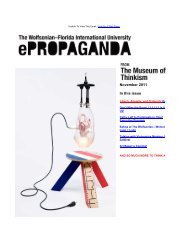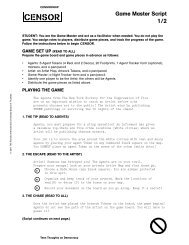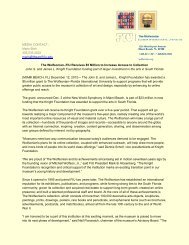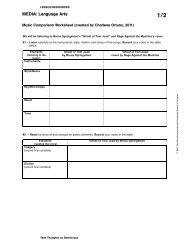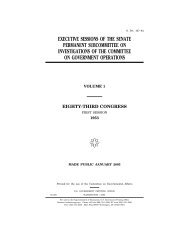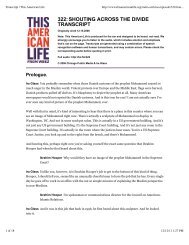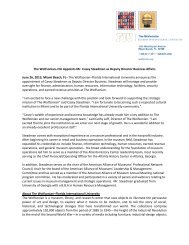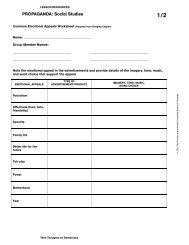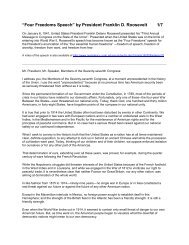the john and drew eberson architectural records ... - Wolfsonian-FIU
the john and drew eberson architectural records ... - Wolfsonian-FIU
the john and drew eberson architectural records ... - Wolfsonian-FIU
You also want an ePaper? Increase the reach of your titles
YUMPU automatically turns print PDFs into web optimized ePapers that Google loves.
For questions contact:<br />
Registrar staff, registrar@<strong>the</strong>wolf.fiu.edu<br />
THE JOHN AND DREW EBERSON ARCHITECTURAL RECORDS ARCHIVE GUIDE TO THE<br />
COLLECTION<br />
The John <strong>and</strong> Drew Eberson Architectural Records Archive includes all materials produced <strong>and</strong><br />
used by John <strong>and</strong> Drew Eberson, Architects for <strong>the</strong> creation of buildings. The archive is one of<br />
The <strong>Wolfsonian</strong>’s major <strong>architectural</strong> holdings, documenting <strong>the</strong> work of <strong>the</strong> firm John <strong>and</strong><br />
Drew Eberson, Architects from 1909 through 1988. John Eberson is known as <strong>the</strong> creator of <strong>the</strong><br />
"atmospheric" style movie palaces <strong>and</strong> credited with designing almost one hundred such<br />
<strong>the</strong>aters throughout <strong>the</strong> country in <strong>the</strong> 1920s. The firm <strong>the</strong>n transitioned to designing <strong>the</strong>aters in<br />
<strong>the</strong> Art Deco style. The atmospheric style is characterized by bringing an opulent <strong>and</strong> exotic<br />
"outdoors" inside to create romanticized indoor "courtyards" bordered by villas <strong>and</strong> tropical<br />
foliage, topped with ceilings painted to look like <strong>the</strong> nighttime sky, complete with stars <strong>and</strong><br />
clouds. As of May, 2008 <strong>the</strong>re were twenty-eight Eberson <strong>the</strong>aters on <strong>the</strong> National Register of<br />
Historic Places. The archive includes <strong>records</strong> for more than 420 projects <strong>and</strong> totals more than<br />
7,600 items. The <strong>Wolfsonian</strong>'s work arranging <strong>and</strong> processing <strong>the</strong> archive was supported by<br />
major grants from <strong>the</strong> Getty Foundation <strong>and</strong> <strong>the</strong> National Endowment for <strong>the</strong> Arts.<br />
The archive is organized into two series: project <strong>records</strong> <strong>and</strong> non-project related material.<br />
Project <strong>records</strong> are sorted in boxes by a project number assigned by John <strong>and</strong> Drew Eberson,<br />
Architects <strong>and</strong> follow a rough chronological order. Materials that do not have a project number<br />
are organized in descending chronological order <strong>and</strong> are identified by project name <strong>and</strong><br />
location.<br />
The Finding Aid <strong>and</strong> Project Index are <strong>the</strong> primary means of browsing <strong>the</strong>se <strong>records</strong> <strong>and</strong> are<br />
accessible from The <strong>Wolfsonian</strong>'s John <strong>and</strong> Drew Eberson Architectural Records Archive main<br />
webpage.<br />
Finding Aid<br />
The Finding Aid includes background information on <strong>the</strong> collection as well as box lists<br />
subdivided into folder lists.
Project Index<br />
The Project Index is <strong>the</strong> primary means of finding materials pertaining to individual projects.<br />
The Project Index is a downloadable Excel spreadsheet listing each project, some basic<br />
information, <strong>and</strong> <strong>the</strong> location of <strong>the</strong> materials at The <strong>Wolfsonian</strong>. This associated material may<br />
include correspondence, oversized material, photographs, or drawings; not all projects will<br />
have all four types of associated materials. Locations are indicated by box numbers <strong>and</strong> folders<br />
within each box. Box numbers contain a letter <strong>and</strong> a hyphen preceding a number which<br />
represents <strong>the</strong> type of material (“C” referring to Correspondence, “O” referring to Oversized<br />
Correspondence, “P” referring to Photographs, <strong>and</strong> “D” referring to Drawings) <strong>and</strong> <strong>the</strong> box<br />
number. The box number is followed by a colon <strong>and</strong> a number indicating folder numbers within<br />
each box. For example, C-21: 1-2 means Correspondence box 21, folders 1 through 2. When<br />
requesting materials, please indicate job number, box number, <strong>and</strong> folder number(s).<br />
Non-project related materials are all materials not directly related to projects including<br />
professional <strong>and</strong> non-professional <strong>records</strong>. These materials are not presented in <strong>the</strong> Project<br />
Index. Box <strong>and</strong> folder listings may be found in <strong>the</strong> Finding Aid under series two.<br />
The John <strong>and</strong> Drew Eberson Architectural Records Archive Guide to <strong>the</strong> Collection, updated Sept 2011<br />
The John <strong>and</strong> Drew Eberson Architectural Records Archive<br />
Guide to <strong>the</strong> Collection, page 2




